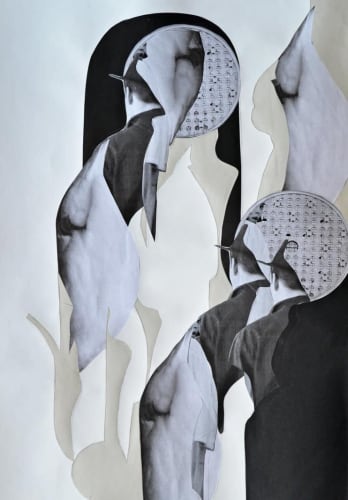Anna Parkina's project features works from different years, thereby giving an idea of the artist's development. During Anna's collaboration with the gallery, this is her second solo exhibition. The first took place in 2015 at the OVCHARENKO gallery (until 2018 — Regina). But even before that, Parkina's works were shown in Moscow, for example, at the opening of Vladimir Ovcharenko's non-commercial project Red October Gallery in the fall of 2012 (with the support of the London gallery Wilkinson). Collaboration with young artists and their active support has always been a distinctive feature of Ovcharenko's institutions.
In the case of Anna Parkina, close attention to her art is due to the fact that the artist's style and ideological quest have always been at the forefront of artistic trends and the mindsets of the European creative youth of the new century. We are talking about the self-organization of artists, the return and reinvention of forms and practices of social activity: the establishment of independent academies, galleries, printing houses, the publication of author's books, magazines, fanzines, various practices of exchange and distribution of information about art.
After art school in Moscow, Anna Parkina graduated from the University of Paris VIII (2002) and the École des Beaux-Arts, Paris (2006). She recalls that "the difference in education was noticeable. Probably the main thing is that in Paris we were taught to start from the idea, and the material and technique were a kind of language for expressing the idea, you could say that the idea dominated the material. But in my education, a big role was played by meeting and communicating with German artists of the "Isotrope Academy" group. This influenced my subsequent "nihilistic" position on high art, art schools, technology, and in many ways shaped the aesthetics inspired by punk, collage, German neo-expressionism, and Dada in my early work." In 2005, Parkina interned at the Art Center College of Design in Pasadena, California, where she worked with artist Mike Kelley and musician Mayo Thompson, and, according to her, it was during this time that she experienced the influence of neo-pop and American film noir of the 40s and 50s.
At the end of the first decade of the millennium, Parkina is among the ten most promising artists, in 2009 she was invited to participate in the Venice Biennale by the Italian Pavilion, and Kim West, a critic from Stockholm, wrote in the Biennale catalogue that Anna Parkina's work achieves "striking visual effects by folding forms and buildings, patterns and objects, silhouettes and contours into and out of each other, creating a multi-layered, ambiguous surface that can evoke the impossible constructions and perspectives of Escher or perhaps even the deceptive images of Magritte." Today, Anna Parkina works in a wide range of artistic media, from performance and sculpture to works on paper, in which she combines collage, watercolor and lithography. Although it must be admitted that collage enjoys a special favor with the author, since the mosaic nature of the image is also present when the artist creates works in watercolor or pencil. This can be considered a response to the challenge of modern visual culture, designed exclusively for simultaneous perception and working against the analytical sequence of information.
Parkina's works do not contain postmodern irony, or the desire to borrow elements of entertainment media - therefore Parkina is often spoken of as a continuer of the traditions of the Russian avant-garde, although it should, of course, be noted the conceptual basis of her works.
The collage nature of her method, revealing gaps and voids, as well as the fragmentariness of the image, encourages a successive, progressive and analytical perception of the complex images of today's reality, which Slavoj Žižek says initially exist in a distorted form: "The place of truth is not in what "things in themselves really are", not in a distorted perspective, but in the gap itself, the transition that separates one perspective from another, i.e. in the gap (in this case: social antagonism), which makes these two perspectives radically incomparable. "The real as impossible" serves as the reason for the impossibility of achieving a "neutral" vision of the object, not distorted by any perspective" (The device of the gap. Parallax vision).
At the exhibition, one can see various techniques and methods of "assembling" the image, which the author uses. This is a listing (in the details of the urban landscape), a comparison (for example, heads and vases in the works "Untitled" and "Stop in the Tunnel"), a suggestive accumulativity ("When There's Nowhere to Go", "Forgot to Turn Off the Screen" - however, in the latter work the title destroys the effect of suggestion). Often the works appear to be in a difficult balance in a state of assembly and disassembly ("Postcard"). But in any case, pauses and emptiness contribute to the active behavior of the viewer, encourage peering, dialogue, perhaps conflict - in a word, they are reactive in the best sense of the word. As the same Zizek wrote, "cogito (Descartes' "I think") as such can appear only in the crevices of substantial communities.

